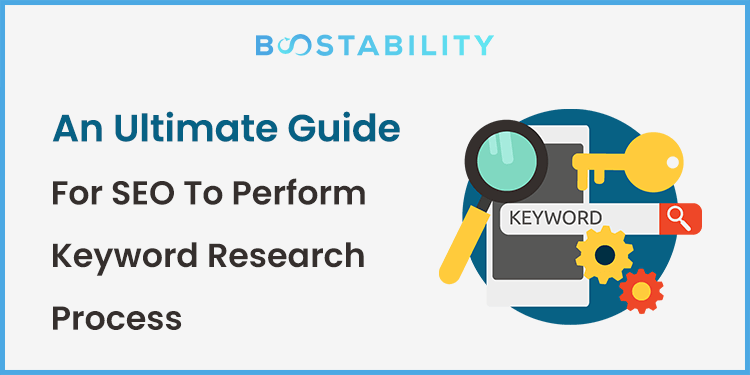Meantime, if you are looking to drive qualified leads for your business site. You should know how to perform keyword research using SEO factors. In this blog from Boostability, we will explain to you the ultimate guide to conduct keyword research for your site by describing why keyword research is vital, how to perform the keyword research using SEO strategy, and select the powerful keywords for your site.
Let us start right away!
Everything About Keyword Research
Keyword research is an effective SEO technique (Search Engine Optimization) that helps find all the powerful search queries. Also, SEO keywords may be like your business customers’ search queries. So, performing keyword research refers to finding and analyzing your business search terms. For instance, keyword research is the same process as your customer’s search on search engines with the target of using your business for their purpose.
Keyword research consists of the following steps: finding, sorting and prioritizing your keywords list based on the search volume, relevance, and SEO ranking factors. You can design your keyword strategy for the best business results by doing SEO keyword research effectively. Further, you can even try to discover queries to target, ranking difficulty, the popularity of these queries, and more.
Why Does Keyword Research Still Play An Important Role For SEO?
Keyword research helps in achieving the following aspects for your site.
- Knows and reach your potential audience.
- Identify new appropriate niches to use on your site.
- Try to get qualified leads.
- Expand your sales growth.
- Improve advertising campaigns, get clicks and impressions.
- Build awareness of your brand.
Keyword research can help prioritize the right SEO keywords for your business site. For example, suppose you have a small or new place with competition on a specific search term, then ranking for those search terms may be a long-term goal or lower priority. Meantime, try to start your keyword research on different achievable short-term keywords to get better SEO results.
Basic SEO Aspects For Keyword Research
Before we jump into the keyword research technique, we will explain a few basic SEO concepts of doing keyword research. A target keyword or keyphrase is the term or phrase you should use for a particular page on your site to become visible on Google. Also, you should determine your set of target keyphrases by performing keyword research.
Keyword Research Your Long-Tail Keywords: Are you doing keyword research for the long-tail SEO keywords? If so, these long-tail keywords are more specific and less searched. Yet, these long-tail keywords are so-called head keywords that focus on your website’s niche. The compelling feature of long-tail keywords is more specific search terms and ranks for the website as there will be less competition. Although few people are searching for these long-tail search terms, it may be driving better engagement to buy, subscribe, sign-up, or whatever you like to do with them.
Determine Your Keyword Strategy
After the keyword research process, make sure to make a keyword strategy. Yet, what’s keyword strategy? On SEO, keyword strategy refers to your decisions depending on your keyword research. For instance, these are the following checklists to determine before making your keyword strategy.
- Which content are you going to create?
- Will you target on the head or tail?
- Where and how will you post your content?
- Will you make a blog, a post or product page, a video tutorial, infographics?
If you find the best keyword strategy solution, kick start completing your keyword research process.
Find Search Intent
The fundamental factor is to research search intent, where you have to find what a searcher needs or likes to look for. It would guide if you did not look only for keywords but also focused on SEO factors. Yet, the target of a searcher(or customer) likes to view, make or buy from your site. Therefore, always your content should offer a solution to searcher’s queries. It is also known as content design.
Step-By-Step SEO Guide For Keyword Research
The fundamental factor is to research search intent, where you have to find what a searcher needs or likes to look for. It would guide if you did not look only for keywords but also focused on SEO factors. Yet, the target of a searcher(or customer) likes to view, make or buy from your site. Therefore, always your content should offer a solution to searcher’s queries. It is also known as content design.
Step-By-Step SEO Guide For Keyword Research
Now, let us start with the step-by-step process of keyword research for improved search engine optimization (SEO) results. It consists of gathering all the possible lists of keywords that may be appropriate to your business site, content, potential customers, products, and services.
Next, after you organize your keywords list, focus on the relevant search terms for your site and users. Last, sort, group, and rank every keyword term.
1. Estimate Your Targets
Before starting your keyword research for SEO, think about your targets. Then, ask yourself the following questions:
- What is the primary goal for your business site?
- What makes your site stand out from the competition?
- Who exactly are you looking to reach?
- What content do you make on your business site?
For the following checklists, take your time to write down your goals. After which, you can find the right solutions for these queries where you are ready to kick start. Now, you have taken the first step in your keyword strategy.
Pro Tip: Always, the business market decides whether your goal will prove to rank higher. Few markets are competitive, with huge companies dominating the search engine results. These higher-ranking companies will have enough budgets for marketing in general and the SEO process. So, competing with these markets looks tougher, so ranking in these markets seems a little complex.
2. Create A List Of Keywords
The next big step is to create a table of your keywords, preferably arranging in a spreadsheet such as Excel or Google Sheets. With the right keywords in mind, try to get the attention of your potential audience. Next, look for the following factors while listing your keywords:
- What do your audiences are looking for from your site?
- What type of keywords or search terms will they be using while checking your products or services?
- Which of their keyword queries does your product resolve?
For these keywords, queries write down as many solutions as possible. If your target is evident, you need to be sure of your niche and unique marketing factors. These are the practical search terms and keywords your business should be visible.
3. Research Your SEO Keywords
You can start your keyword research for SEO using the Google search engine. First, Google the keywords that you come up with and check the searches from Google suggests while you are doing searches. For example, “how to do SEO keyword research.” Also, you can check out the related searches on the Google results page. For instance, “keyword research tools.”
Pro Tip: You can try to use a keyword research tool because it offers your site every type of variation of keyphrases, synonyms, and relevant keyphrases. Also, check out and add every keyphrase to your list.
4. Focus On Long-Tail Keywords
When business owners begin with keyword research, they target trendy head terms. But, alas! Larger companies often take these head keywords. Meantime, long-tail keywords get lesser search traffic, but there’s less competition. Hence, it is simple for you to rank on these keywords. Also, these long-tail keywords have got a higher conversion rate as it targets more on exact products or niche.
Furthermore, long-tail keywords are longer and target more than a head term. For example, your head term is puppy training; then the long-tail keywords can be positive puppy training for Labradoodles. So, using keyword research tools will help you identify more long-tail variations on your keywords.
Factors Of Keyword Research For SEO
Here are three primary factors to consider while doing your keyword research.
- Relevance
- Authority
- Volume
Final Takeaways
In conclusion, when your keyword research works best, you can generate targeted content that engages followers and leads to more conversions. I hope you like this blog of the Ultimate Guide For SEO To Perform Keyword Research. Also, you can now connect with Boostability to perform the best SEO keyword research process for your business site. After which, you can have a list of keywords that help focus on the right business niches for your website and achieve your few short-term and long-term gains.
Above all, be sure to re-evaluate these keywords every few months once a quarter that serves as the best criteria. Yet, few businesses like to make it even more frequent as it can gain more rank in the SERPs. You can find that by including more keywords on your table to handle as you work on keeping your present situation and then growing in new fields on the top of the list.

Author: Jariya Farveen
Hey! there Jariya Farveen, is a Content Writer with years of experience curating blogs, articles, websites, social media content, and more. She has been supporting the B2B and B2C clients by weaving words to attain their marketing goals.

